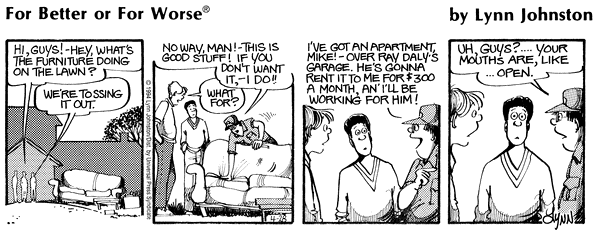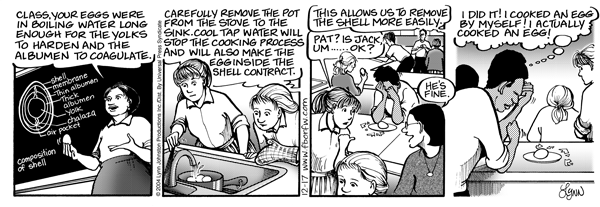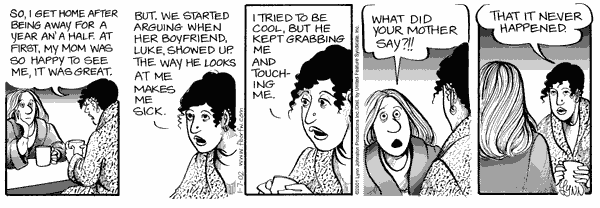We like to cheer on the underdogs because their fortune is a kind of reassurance that there is, in fact, a way to beat the odds and succeed. The Pattersons encounter a few underdogs and it’s not always obvious who they are. Here are five of the most loved characters who we either didn’t expect to succeed, or whom we didn’t really think of as underdogs right away.
#1. Gordon Mayes
One of the things about children in abusive homes that almost never gets talked about is the fact they often don’t have the same kinds of opportunities that other children have. For the most part, those children know that their home situation isn’t ideal; especially when contrasted with those of their friends.
Gordon doesn’t talk much about how it is at home, but through various strips, we infer that his father hits him a lot and his parents are not on the best of terms. Luckily for Gordon, he’s got access to a supportive community. At 19, he moves away from home and into the flat on top of the local garage. With the help of his friends, he moves in and is able to score an old couch that Mike’s parents are throwing out. Gordon doesn’t much care about the state of the couch because he didn’t have one to begin with.
Gordon’s story arc, shows us a young man determined to make a life for himself that he can be proud of and through hard work, trustworthiness, and determination, he ends up not only the new owner of Ray Daly’s Garage, but marries his high school sweetheart, Tracey, and opens up a cafe as well.
#2. Shannon Lake
Human beings, and specifically children and teens, can be scathing and cruel to those they deem as “other”. We rarely get to see people in the “other” groups find the courage and the support to stand up against the cruelty and ridicule when it happens. Shannon’s story gives us that much needed feel-good boost because not only does Shannon bear the brunt of the snide remarks and ridicule with aplomb and snark, but with the support of April, manages to stand up loudly against it
However, there are several other issues that Shannon’s story shows us: how “normal” for us can sometimes be a challenge for those with learning difficulties, how things such as being able to read and write are skills that are taken for granted, and how people like Shannon get to work around those barriers in ways that we think are “cute” or “lucky” or “privileged” – like how Shannon takes notes in class with a recorder instead of a pencil and paper. Sometimes we forget how simple things – like boiling an egg – are a lot more of a challenge for some; and how much joy people get from accomplishing those tasks.
If nothing else, Shannon’s story reminds us of three things:
- never take things for granted – sometimes accomplishing the smallest of tasks is a huge accomplishment for someone, somewhere
- “other” should never mean ridicule and cruelty, but calls for empathy and understanding and acceptance without judgment.
- even the most challenged among us have something to say and can make a difference.
#3. Candace Halloran
Candace’s story comes at us in a different manner. We first are introduced to her through the eyes of her peers. In high school, we see Dawn and Liz talking about a group project for which Dawn says she promised Candace she’d work with her. Most of Candace’s story is told through Liz, Dawn, and Anthony and we get the distinct impression that Candace is not a team player. We start out not liking Candace at all. I mean, who likes the person who makes the rest of the group do all the work in a group project, right?
We’re even more askance when we see Candace after she shaves her head. She comes across as snobbish and elitist because she loudly proclaims that people must accept her for who she is instead of for her attributes – namely her “perfect hair”. It feels like an attempt to force approval from her peers and there is a small feeling of schadenfreude when she gets teased for her shaved head.
Later on, we learn from Candace herself, that her home life has been anything but “normal” and we get a brief glimpse into what it must be like to be Candace. It is much later in the storyline, and the kids are off at college but home for the December holidays. Candace shows up at the Pattersons’ and asks to stay the night. She tells Liz how her mother fights with her and how her mother’s boyfriend is targeting her with uncomfortable attention, leaning towards sexual assault. It feels like a brutal blow to our initial impression of her, and rightly so.
There’s a lesson here too – when we encounter difficult people who try our patience, it is often important to remember that everyone is fighting their own private battles. Candace rises above her abuse; she is in college, she knows she has a safe haven for when she feels unsafe, and she has friends she can count on and she makes use of that later on life, even if she didn’t ask for help or talk about her challenges as a child.
#4. Shiimsa
Feral cats get a bad rap. They’re seen by many as dangerous and invasive, most likely because they tend to be destructive of their surroundings and can be aggressive when cornered. It is also possible that there are some cultural hangups about them as well – we tend to think of cats as standoffishly affectionate, and feral cats are more standoffish than affectionate. But just like other stereotypes, feral cats can be just as companionable as fully domesticated ones and Shiimsa comes along to remind us of that.
When Liz first sees Shiimsa, she is resistant to taking her in. Gradually, Shiimsa wins her over with her playfulness and affection. Even her name (which is “little friend from the animal world” in Ojibwe) is a testament to the role she played in Liz’s life. Shiimsa is generally the mischievous cat that you might expect her to be, but she’s also super affectionate and she quickly becomes an integral part of Liz’s life.
#5. Agnes Dingle
Mrs. Dingle features in very few strips but where she does make an appearance, she embodies a kind of mother-figure to Michael and his friend Josef ‘Weed’ Weeder. At first, she seems stern and unapproachable, but we learn that she can be fun loving as well.
Mrs. Dingle becomes such an integral part of the story that later on, even after the boys have left college and moved on, it is as if she is still a part of the family. Mike remembers her, and tries to call and say hello and finds she doesn’t answer the phone. He then asks a neighbour to check in on her and learns that she had fallen ill.
As much as Mrs. Dingle had always seemed like a cranky landlady who was best avoided, Michael and Weed learned her life story, discovered she was a kind person under her gruff exterior, and the three ended up as friends.
Last Words
Lynn loves a good underdog story; we all like to cheer them on, in spite of their flaws or challenges, because we can relate. Since FBorFW progressed in real time, it sometimes took twenty years for us to see how the characters turned out! We hope that by highlighting these characters here, exploring their backstories and highlighting their relationships, that you can root for them too.







